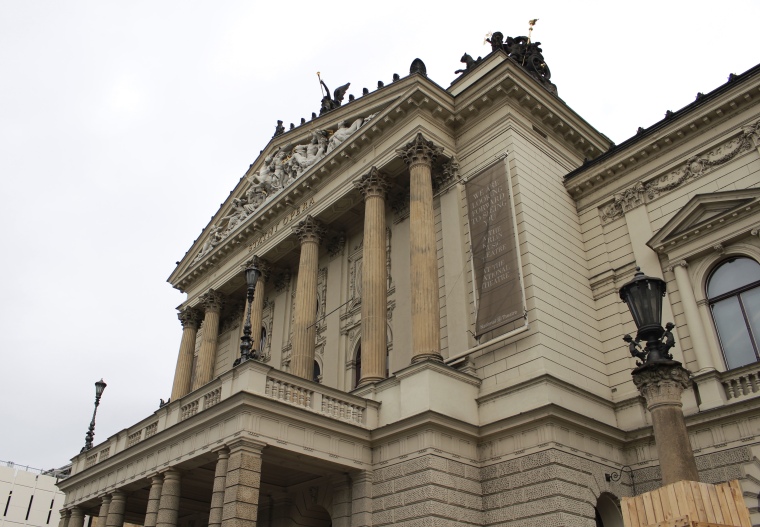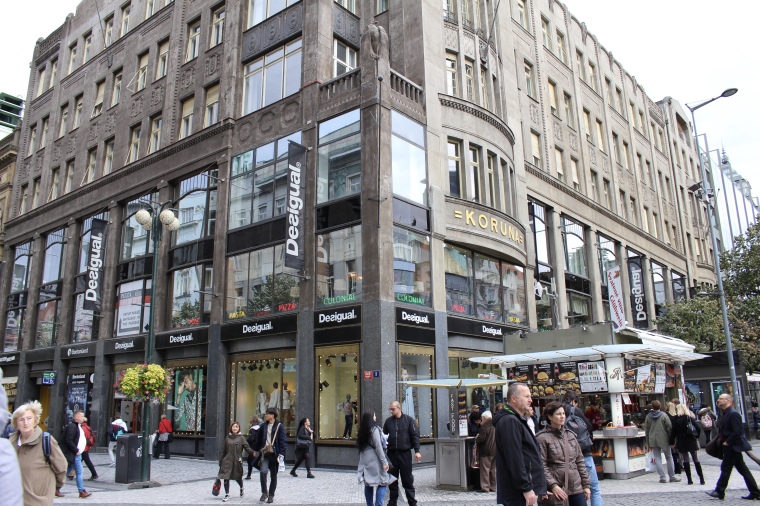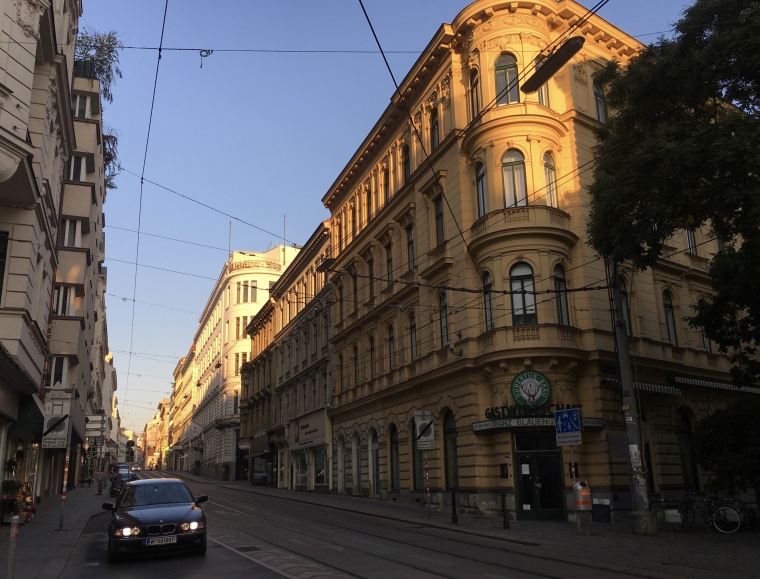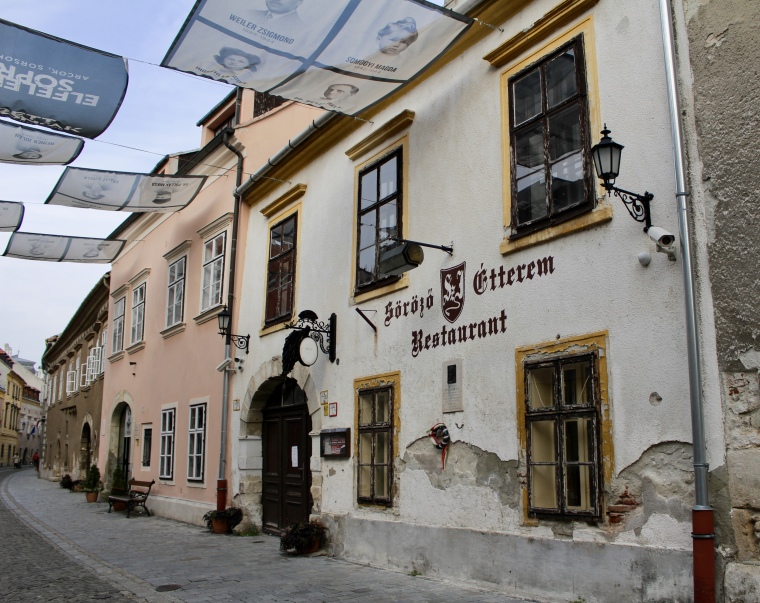Friday, October 6: Our last day in Prague, we finally head out to see the highlights of the city, Staré Město (the Old Town) & Josefov (the Jewish Quarter). I wanted to save it for a sunny day, so luckily we got some blue skies.
This is our stately Airbnb apartment building in Vinohrady. Our apartment is on the second floor of the tan building closest to the camera.
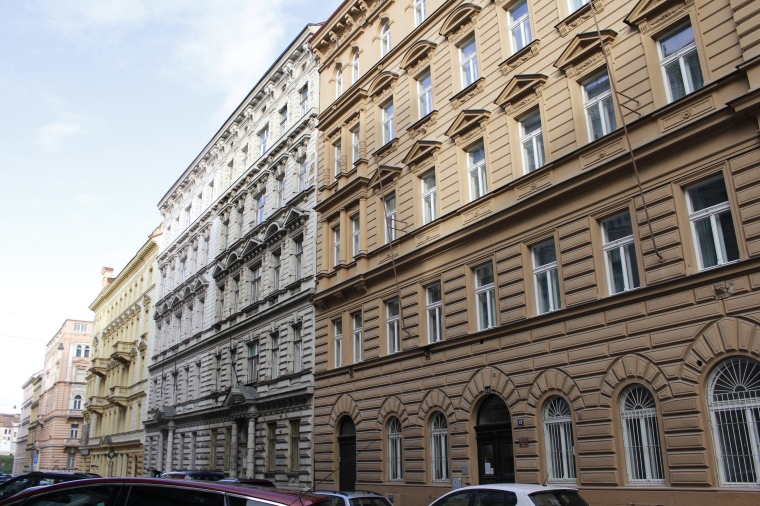
We hop on metro at the Namesti Meru station.

The diverse architecture in the Old Town is quite impressive, showcasing Art Nouveau, Gothic, Renaissance, Baroque and Rococo.

The Memorial to Jan Hus dominates Old Town Square. Born in 1369, he was a priest who stood up to both the Catholic Church and the Austrian Habsburg royal family. For this, he was arrested, charged with heresy, excommunicated, and finally burned at the stake in 1415. He inspired the Hussite movement, a pre-Protestant Christian movement calling for reformation of the Catholic Church.
The huge monument, unveiled in 1915 to commemorate the 5ooth anniversary of the hero’s martyrdom, depicts victorious Hussite warriors and Protestants who were forced into exile 200 years after Hus, as well as a young mother and her children who symbolize national rebirth.

I love the architectural flourishes adorning the buildings around Old Town Square.

The green domed Baroque Church of St. Nicholas stands in one corner of the square. Once Catholic, now Hussite, the church is now a popular concert venue.

Around a corner, we’re awed by some beautifully adorned buildings.


The Old Town Hall is under renovation and covered in ugly blue mesh. Luckily, the Astronomical Clock is visible. The Old Town Hall was established in 1338, during the Bohemian Golden Age (c. 1200-1400). The Astronomical Clock’s mechanics are complex; you can read about how it works here. Every hour between 9 a.m. and 11 p.m., the twelve apostles appear, along with other moving sculptures—notably a figure of Death (represented by a skeleton) striking the time. A calendar dial with medallions represents the months.
The twin Gothic spires of the Church of Our Lady Before Týn are iconic symbols of Prague. In medieval times, the church was Catholic. For a period, it was Hussite, and now it’s Catholic again. The spires are decorated with a golden image of the Virgin Mary made from a melted down Hussite chalice that once adorned the church. It has been the main church of the Old Town since the 14th century.


The yellow building with the flags is an Art Nouveau building, recognized as such by its pastel color, wrought iron balconies, colorful murals, and ornate stonework.




We dip to the Basilica of St. James, founded in 1232 and built originally as a Gothic church; it is known for being the most beautiful church interior in the Old Town. In 1689, the original interior was destroyed by fire; this is an 18th century Baroque renovation. The bejeweled Madonna Pietatis hangs at the altar; above her hovers a painting of the martyrdom of St. James.

A mummified forearm hangs to the right of the tomb entrance, dating back over 400 years. Legend has it that a jewel thief tried to steal the jewels on the altar, and the Madonna grabbed his arm and would not let go; his arm was cut off by monks to free him from the Virgin.
Besides the blooming of Art Nouveau architecture in Prague, Cubism also flourished in the city. The Cubist-inspired House of the Black Madonna, built in 1912 by Josef Gočár, has rectangular windows and cornices; it is both “avant-garde and … traditional at the same time.” According to Cubism in Architecture: A Short Amusement of the Past, “Cubist architecture did not totally deny the experience of the past. It only decorated the facades of buildings with new ornaments but the structure remained the same.”

We stop for a snack of coffee and pastries.

We continue our walk past the 1780s Estates Theater, a Classicist building and a prime opera venue in Prague; here, Wolfgang Amadeus Mozart premiered Don Giovanni in 1787 and directed many of his works (Rick Steves Pocket Prague).
The 500-year-old Powder Tower was once the town’s main gate, as well as storing Prague’s gunpowder. It served as the city’s formal front door, welcoming royalty and dignitaries.
The Gothic facade of Powder Tower is carved with Prague’s coat of arms, a pair of Czech kings, golden-winged angels, and Christ with his saints.

Next to Powder Tower is the Municipal House, a celebration of Art Nouveau with its organic flowing and curvaceous lines, its wrought iron balcony and colorful mosaics. Built in the early 1900s and restored in the 1990s, it is considered “the pearl of Czech Art Nouveau” (Rick Steves Pocket Prague). A movement that was a reaction to 19th century academic art, Art Nouveau is inspired by natural forms and structures, particularly the curved lines of plants and flowers. It was popular between 1890 and 1910. Prague is considered by many to be Europe’s best city for Art Nouveau.

The mosaic above the balcony, a symbol of the city, is called Homage to Prague. Here, the goddess Praha oversees a peaceful and highly cultured society. In 1918, when Czechoslovakia was formed, independence was proclaimed from the balcony of the Municipal House.

We make our way to the outdoor market, Havel’s Market (Havelske trziste), a permanent market in the city center.

Stalls at Havelske trziste offer arts and crafts, wooden toys and puppets, flowers, leather goods, ceramics, paintings and fruits and vegetables, as well as tourist souvenirs (Prague Experience: Shops and Markets). Though a colorful market, I find it less enticing than the markets we found in Budapest and Vienna.

I love simply strolling down Prague streets and admiring the architectural exuberance of the buildings.
On our way to the Jewish Quarter, we walk past St. Francis of Assisi Church. The first St. Francis Church was established here in the 13th century. The current church was consecrated in 1688 by the Archbishop of Prague in honor of Saint Francis of Assisi. It houses a unique baroque organ which was built in 1702, and today classical and organ concerts are held here.

The late-14th-century Old Town Bridge Tower sits at the eastern end of Charles Bridge. It was built as both fortification and a triumphal arch marking the entrance to the Old Town (Lonely Planet: Prague).



We walk past the front of St. Francis of Assisi Church, with its religious figures standing authoritatively along the balcony, as if about to give a stern sermon.

For the second time, on Charles Bridge, we pass by St. John of Matha, St. Felix of Valois and St. Ivan, a 1714 statue of the 17th century French founders of the Trinitarian Order.

We also have views north up the Vltava River to Mánes Bridge.

The Crucifix and Calvary sculpture is one of the oldest sculptures on Charles Bridge. The original wooden crucifix was installed soon after 1361 and likely destroyed by the Hussites in 1419. A new crucifix with a wooden corpus was erected in 1629 but was severely damaged by the Swedes towards the end of the Thirty Years’ War. This was replaced by another wooden Calvary which, in turn, was replaced with a metal version in 1657. The present sandstone statues portray the Virgin Mary and John the Evangelist (Wikipedia: List of Statues on Charles Bridge).

The statue says in Hebrew “Holy, holy, holy, the Lord of Hosts;” this is considered to be a symbolic humiliation and degradation of Prague Jews, as they were forced to pay for a set of golden letters referring to God and hung around the neck of the statue of Christ (Wikipedia).

Prague Castle sits majestically on a hill over the Vltava River.

Heading toward the Jewish Quarter, we pass the neo-Renaissance Rudolfinum, built between 1875 and 1885; it is connected to another great figure of classical music, the Czech Antonín Dvořák. Here, he personally conducted the Czech Philharmonic Orchestra for the premiere of his famous New World Symphony (Avant Garde Prague: The Rudolfinum).

I have become addicted to dumplings of all kinds here in Prague, and at lunchtime at the mistral cafe, I sample yet another kind. These are a bit dry, with no gravy or sauce, but still tasty. No wonder I so easily gained back the weight I lost in Japan!

We arrive in the Jewish Quarter only to find that everything is closed today because it’s Sukkot, a Jewish holiday. We should have checked this out earlier!
The Old-New Synagogue, closed today, is Prague’s oldest active synagogue and one of Prague’s earliest Gothic buildings.

The Ceremonial hall near the Old Jewish Cemetery was a mortuary house used to prepare bodies and perform purification rituals before burial.

Sadly, we can only peek into the Old Jewish Cemetery through a closed gate. It is Europe’s oldest surviving Jewish graveyard, with (apparently) 12,000 jumbled stones, under which are perhaps 100,000 graves, piled in layers in a limited space. I’m disappointed that we can’t go in today because it is considered an emotionally moving experience.

After leaving the Jewish Quarter, we take 1-hour boat cruise on Prague Boats on the Vltava River, starting near the Mánes Bridge, a road and tramway bridge.


The neo-Baroque Straka Academy, on the west bank of the Vltava, is the government seat of the Czech Republic. It was designed by the architect Václav Roštlapil and built between 1891 and 1896.


From the boat, we see views of both shores of the river, and most of the sights we’ve already visited.
I love the view of Prague Castle from the boat.


Finally, we take the metro back to our neighborhood.

We pop into a cozy spot, Restaurace Kravín, for a couple of beers before going back to our apartment.
After a short rest at our apartment, we go to a fabulous restaurant, Matylda Restaurant, for dinner. I love finding local restaurants off the tourist track. My bread pizza has cream, herb pesto, blue cheese, Edam, Parmesan cheese, green pepper, goat cheese and scallions. It’s delicious and the atmosphere is a cozy and welcoming escape from the cold.
Tomorrow, we fly back home, sad to see our holiday come to an end.
Steps today:15,024 (6.37 miles)
Saturday, October 7: We get an airport cab to the airport for our morning flight, with a stopover at Frankfurt airport. There we have lunch and beers before continuing our long flight back over the pond.
Our trip to Eastern Europe has sadly come to an end!
This post is inspired by Jo’s Monday Walk.




























































